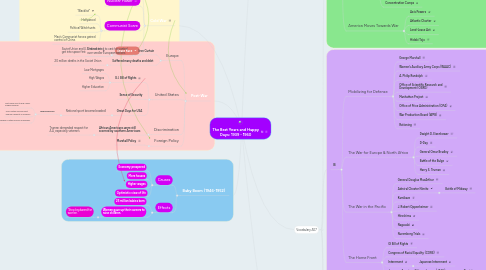
1. Cold War
1.1. Iron Curtain
1.1.1. Blockade around Berlin by Soviet
1.1.1.1. Berlin Air Lift
1.2. Nuclear Power
1.3. Communist Scare
1.3.1. "Blacklist"
1.3.2. Hollywood
1.3.3. Political Witchhunts
1.3.4. Mao's Communist forces gained control of China.
1.4. Space Race
1.4.1. Soviet Union and U.S. raced to get into space first
2. Baby Boom (1946-1952)
2.1. Causes
2.1.1. Economy prospered
2.1.2. More houses
2.1.3. Higher wages
2.1.4. Optimistic view of life
2.2. Effects
2.2.1. 25 million babies born
2.2.2. Women gave up their careers to raise children.
2.2.2.1. "Step backward for women."
3. Post-War
3.1. Europe
3.1.1. Iron Curtain
3.1.1.1. Stalin started to cast his control over smaller European nations
3.1.2. Suffered many deaths and debt
3.1.2.1. 20 million deaths in the Soviet Union
3.2. United States
3.2.1. G.I. Bill of Rights
3.2.1.1. Low Mortgages
3.2.1.2. High Wages
3.2.1.3. Higher Education
3.2.2. Sense of Security
3.2.3. Great Days for USA
3.2.3.1. National sport became baseball
3.2.3.1.1. Jackie Robinson
3.3. Discrimination
3.3.1. African Americans were still scorned by southern Americans
3.3.1.1. Truman demanded respect for A.A, especially veterans
3.4. Foreign Policy
3.4.1. Marshall Policy
4. Japanese American Citizens League (JACL)
5. Eisenhower Adminstration
5.1. Prosperous Economy
5.1.1. People bought many things
5.1.1.1. Citizens were able to buy things that they didn't need, sometimes just to compete with neighbors.
5.1.2. Wages grew
5.1.3. More "white-collared" jobs
5.2. Dwight David Eisenhower
5.2.1. Resolved the Korean conflict (Forgotten War)
5.2.2. First U.S president to use television to"advertise" himself
5.3. Culture
5.3.1. Music
5.3.1.1. "Black" music was "risque"
5.3.1.1.1. Lloyd Glenn
5.3.1.1.2. Elvis Presley
5.3.2. Art
5.3.2.1. Playboy
5.3.3. The Power of Television
5.3.3.1. "I Like Ike"
5.3.3.2. 50s were dominated by the television medium
5.3.3.2.1. Commercials were becoming widely used and targeted families
5.3.3.3. Radios became abandoned
5.3.3.3.1. Some newscasters made the transition
5.3.3.4. TV Shows
5.3.3.4.1. Robin Williams
5.3.3.4.2. Competitions
5.3.4. Cars
5.3.4.1. Highways were built
5.3.4.2. defined personality
5.3.4.2.1. Ford Thunderbolt
5.3.4.3. Businesses were based/incorporated automobiles
5.4. Society
5.4.1. Women's Role
5.4.2. Civil Rights Movements
5.4.2.1. Sparked by Rosa Parks
5.4.2.2. Martin Luther King Jr,
5.4.2.2.1. Desegregration of Schools
5.4.2.2.2. Peaceful protest against buses by boycott.
6. Vocabulary A07
6.1. A
6.1.1. Dictators Threaten World Peace
6.1.1.1. Joseph Stalin
6.1.1.2. totalitarian
6.1.1.3. Benito Mussolini
6.1.1.4. Fascism
6.1.1.5. Adolf Hitler
6.1.1.6. Nazism
6.1.1.7. Fracisco Franco
6.1.1.8. Neutrality Acts
6.1.1.8.1. U.S. sent aid to China because Japan never officially declared war.
6.1.2. War in Europe
6.1.2.1. Neville Chamberlain
6.1.2.2. Winston Churchhill
6.1.2.3. Appeasement
6.1.2.4. Non-agression Pact
6.1.2.5. Blitzkreig
6.1.3. The Holocaust
6.1.3.1. Holocaust
6.1.3.2. Genocide
6.1.3.3. Kristallnacht
6.1.3.4. Concentration Camps
6.1.4. America Moves Towards War
6.1.4.1. Axis Powers
6.1.4.2. Atlantic Charter
6.1.4.3. Lend-Lease Act
6.1.4.4. Hideki Tojo
6.2. B
6.2.1. Mobilizing for Defense
6.2.1.1. George Marshall
6.2.1.2. Women’s Auxiliary Army Corps (WAAC)
6.2.1.3. A. Philip Randolph
6.2.1.4. Office of Scientific Research and Development (OSRD)
6.2.1.5. Manhattan Project
6.2.1.6. Office of Price Administration (OPA)
6.2.1.7. War Production Board (WPB)
6.2.1.8. Rationing
6.2.2. The War for Europe & North Africa
6.2.2.1. Dwight D. Eisenhower
6.2.2.2. D-Day
6.2.2.3. General Omar Bradley
6.2.2.4. Battle of the Bulge
6.2.2.5. Harry S. Truman
6.2.3. The War in the Pacific
6.2.3.1. General Douglas MacArthur
6.2.3.2. Admiral Chester Nimitz
6.2.3.2.1. Battle of Midway
6.2.3.3. Kamikaze
6.2.3.4. J. Robert Oppenheimer
6.2.3.5. Hiroshima
6.2.3.6. Nagasaki
6.2.3.7. Nuremberg Trials
6.2.4. The Home Front
6.2.4.1. GI Bill of Rights
6.2.4.2. Congress of Racial Equality (CORE)
6.2.4.3. Internment
6.2.4.3.1. Japanese Internment
6.2.4.4. Japanese American Citizens League (JACL)
6.2.4.4.1. Persistence
6.3. C
6.3.1. Origins of the Cold War
6.3.1.1. United Nations (UN)
6.3.1.2. Satellite Nation
6.3.1.3. Containment
6.3.1.4. Iron Curtain
6.3.1.5. Marshall Plan
6.3.1.6. Cold War
6.3.1.7. Berlin Airlift
6.3.1.8. Truman Doctrine
6.3.1.9. North Atlantic Treaty Organization (NATO)
6.3.2. The Cold War Heats up
6.3.2.1. Chiang Kai-shek
6.3.2.2. Mao Zedong
6.3.2.3. Taiwan
6.3.2.4. Korean War
6.3.2.5. 38th Parallel
6.3.3. The War at Home
6.3.3.1. McCarthysim
6.3.3.2. Ethel and Julius Rosenberg
6.3.3.3. Alger Hiss
6.3.3.4. Joseph McCarthy
6.3.3.5. Blacklist
6.3.3.6. Hollywood Ten
6.4. D
6.4.1. Post War America
6.4.1.1. GI Bill of Rights
6.4.1.2. Dixiecrat
6.4.1.3. Fair Deal
6.4.2. The American Dream in the Fifties
6.4.2.1. Baby Boom
6.4.2.2. Consumerism
6.4.2.3. Conglomerate
6.4.2.4. Franchise
6.4.2.5. Dr. Jonas Salk
6.4.2.6. Planned Obsolescence
6.4.3. Popular Culture
6.4.3.1. Mass Media
6.4.3.2. Federal Communications Commission (FCC)
6.4.3.3. Rock 'n' Roll
6.4.3.4. Jazz
6.4.4. The Other America
6.4.4.1. Urban Renewal
6.4.4.2. Termination Policy
